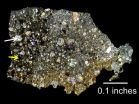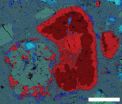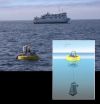(Press-News.org) A research group in the UA Lunar and Planetary Laboratory has found evidence in meteorites that hint at the discovery of a previously unknown region within the swirling disk of dust and gas known as the protoplanetary disk - which gave rise to the planets in our solar system.
Led by Kelly Miller, a doctoral student in the lab of Dante Lauretta, the principal investigator of NASA's OSIRIS-REx mission, the team has found evidence of minerals within meteorites that formed in an environment that was enhanced in oxygen and sulfur and date from a time before the particles stuck together, or "accreted," to form larger bodies such as asteroids and planets.
Miller will present the data at the 46th Lunar and Planetary Science Conference, which is held March 16-20 in The Woodlands, Texas. The results are in preparation for publication in a journal, but have not been peer-reviewed yet.
The elements that later went on to constitute the major ingredients in life on Earth - such as carbon, oxygen, nitrogen and hydrogen - originated as volatile gases in the protoplanetary disk when the solar system was less than 10 million years old, Miller said.
"If we want to understand how those elements contributed to life, we have to understand where they occurred at the time the solar system formed," she said.
Miller and her team study meteorites called chondrites, which are thought to be the most primitive leftovers from the birth and infancy of the solar system about 4.6 billion years ago. They derive their name from their main component - chondrules, which formed as molten droplets floating in space.
"We think that chondrites represent the earliest building blocks of rocky planets such as Earth, Mars or Venus," Miller said.
Specifically, Miller and her co-workers studied sections about half as thin as a human hair that were cut from R chondrites, a rare type of meteorite so named after the location where the type specimen fell: Rumuruti in Kenya. R chondrites are thought to have formed somewhere between Earth and Jupiter. In one specimen, found in Antarctica, they discovered a new type of building block called sulfide chondrules. The samples were obtained from the U.S. collection of Antarctic meteorites - a cooperative effort among NASA, the National Science Foundation (NSF) and the Smithsonian Institution.
"Generally, chondrules are made up of minerals rich in silicon, but the chondrules we found in this meteorite are completely different in that they are composed of sulfide minerals," she explained. "This suggests that they formed in a region that was rich in sulfur, and provides evidence for a previously unknown type of environment in the early solar system."
"Our discovery of the sulfide chondrules will help us put a quantifiable number on how much sulfide was enhanced in that region of the protoplanetary disk," Miller added.
Obtaining a better understanding of the distribution of gases in the early solar system has been identified by the Planetary Science Decadal Survey as a primary objective for the study of primitive bodies. Published by the National Research Council for NASA and other government agencies such as the National Science Foundation, the document identifies key questions in planetary science and outlines plans for space- and ground-based exploration ten years into the future.
"What is exciting about this sample is that it has not been heated to high temperatures and thereby altered in its composition," Miller said. "We know it's a fragment of a larger asteroid, and some of that asteroid heated up to higher temperatures, erasing the signature of the original building blocks of the asteroid, but our piece retains the original building blocks."
"These sulfide chondrules help us pin down when and where that sulfur enhancement occurred and help us better understand the process," she added.
To learn more about the early stages of the solar system including the origin of the building blocks of life and water, the UA-led OSIRIS-REx mission is getting ready to launch a robotic spacecraft to asteroid Bennu in 2016 and bring a sample of at least 60 grams of pristine material back to Earth for study. The mission will provide ample amounts of sample material and, most importantly, from a known context.
"Unlike with meteorites that came to us serendipitously and we're lacking the context of where the material formed, with OSIRIS-REx we will know exactly where that piece came from, and we will know the travel history of Bennu - where it has been in the past," Miller said.
INFORMATION:
To learn more about Bennu's past and the OSIRIS-REx sample return mission, visit the OSIRIS-REx Website and watch the short documentary, "History of Bennu".
Researchers from the University of Hawai'i - M?noa (UHM) and colleagues found that microbial communities in different regions of the Pacific Ocean displayed strikingly similar daily rhythms in their metabolism despite inhabiting extremely different habitats - the nutrient-rich waters off California and the nutrient-poor waters north of Hawai'i. Furthermore, in each location, the dominant photoautotrophs - light-loving bacteria that need solar energy to help them photosynthesize food from inorganic substances - appear to initiate a cascade effect wherein the other major ...
The studies below will be presented at the American College of Cardiology's 64th Annual Scientific Session on Sunday, March 15.
1. Survey Suggests Cardiologists May Not Be Prepared to Counsel Patients on Heart Healthy Diets
Even though most doctors believe diet is important in preventing and managing cardiovascular disease, there are major gaps in their knowledge and, in turn, efforts to educate patients about heart healthy diets may be falling short, according to a recent survey of 236 cardiologists and internal medicine physicians and trainees at a large tertiary ...
Patients who received the new drug Bendavia before undergoing angioplasty or receiving a stent to clear blocked arteries after a heart attack showed no significant reduction in scarring as compared to patients given a placebo, according to a study presented at the American College of Cardiology's 64th Annual Scientific Session.
The study is the first randomized, controlled trial of Bendavia, a drug designed to reduce the extent of tissue damage in the heart through a new approach that targets mitochondria in the cells. Although patients receiving the drug showed a 10 ...
SAN DIEGO (March 15, 2015) -- A novel therapy that would allow doctors to turn the body's blood-clotting ability off and on in a more controlled way was about as effective as established anticoagulants in patients undergoing angioplasty but was associated with higher rates of moderate to severe bleeding, according to an analysis of data from a terminated Phase III trial presented at the American College of Cardiology's 64th Annual Scientific Session. The study was officially halted in August due to an excess of severe allergic reactions, so authors caution that the data ...
SAN DIEGO (March 15, 2015) -- Use of computed tomography coronary angiography, which provides 3-D images of the heart, coupled with standard care allows doctors to more accurately diagnose coronary artery disease in patients presenting with chest pain, therefore, leading to more appropriate follow-up testing and treatments, according to research presented at the American College of Cardiology's 64th Annual Scientific Session. Data also showed a trend toward a lower incidence of heart attacks among the group receiving the tests, known as CT scans, compared to usual care. ...
SAN DIEGO (March 15, 2015) -- Patients taking evolocumab--an investigational therapy previously shown to dramatically lower "bad" cholesterol--were half as likely to die, suffer a heart attack or stroke, be hospitalized or need a procedure to open blocked arteries compared with those who received standard care, according to research presented at the American College of Cardiology's 64th Annual Scientific Session in San Diego.
In this open-label study, the rate of cardiovascular events was 2.18 percent after one year in the standard of care group, most of whom were on ...
SAN DIEGO (March 15, 2015) -- The SAPIEN 3 heart valve demonstrated lower death, stroke and paravalvular leak rates than earlier generation devices in patients at high risk for surgery and showed encouraging results in intermediate-risk patients, according to research presented at the American College of Cardiology's 64th Annual Scientific Session.
Transcatheter aortic valve replacement, known as TAVR, is approved for patients with severe aortic stenosis--narrowing of the valve in the heart's main artery--whose health profile makes them ineligible or high-risk candidates ...
SAN DIEGO (March 15, 2015) -- An investigational device that deflects debris away from the brain during transcatheter aortic valve replacement seems to improve in-hospital safety outcomes and cognitive scores at discharge, according to preliminary findings from a small randomized study presented at the American College of Cardiology's 64th Annual Scientific Session.
The valve replacement procedure, known as TAVR, dislodges minute particles from the clogged valve, freeing them to float through the bloodstream. Much of this debris travels "downstream" from the heart, but ...
SAN DIEGO (March 15, 2015) -- Five-year data suggest that the SAPIEN transcatheter heart valve is a feasible option for patients with severe aortic stenosis deemed to be at high risk for open-heart surgery, though valve leakage was more common with the first-generation valve evaluated in this study than with surgery, according to research from PARTNER I presented at the American College of Cardiology's 64th Annual Scientific Session.
When the blockage of an aortic valve becomes severe, replacement is the only real treatment choice, but many elderly and frail people are ...
SAN DIEGO (March 15, 2015) -- Two-year data show a continued survival advantage for self-expanding transcatheter aortic valve replacement (TAVR) over standard surgery in high-risk patients with severe aortic stenosis, according to research presented at the American College of Cardiology's 64th Annual Scientific Session.
Aortic stenosis--a problem that occurs when the valve in the heart's main artery doesn't open fully--forces the heart to work harder to pump blood and is life-threatening over time. Valve replacement is common when this condition becomes severe, but the ...



